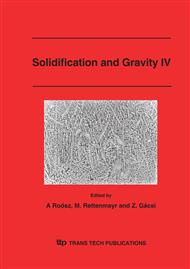p.431
p.437
p.443
p.449
p.455
p.461
p.463
p.473
p.479
Solidification of Co-Cu Alloys in the Metastable Miscibility Gap under Low Gravity Conditions
Abstract:
Liquid Cu-Co shows a metastable miscibility gap where the homogeneous melt separates into the Co-rich L1-liquid and the Cu-rich L2-liquid. The required undercooling of the melt of > 120 K can be achieved by containerless methods as electromagnetic levitation, laser melting or drop tube processing. Due to the large undercooling, rapid solidification of the melt is favoured and preserves microstructure features of the metastable (liquid) phases. In Co-84.0 at% Cu alloy the L1- phase nucleates in the Cu-rich majority phase L2 as a dispersion of spherical droplets. Convective flow in the liquid influences largely the time evolution and the nature of the droplet dispersion and makes a theoretical description of the droplet growth extremely difficult. In the present work droplet dispersions are compared which formed under processing methods with different levels of convection: (i) (Terrestrial) electromagnetic levitation (EML), (ii) processing in the TEMPUS facility under parabolic flight conditions and (iii) processing in an 8 m drop tube. The distributions of droplet radii of the L1-phase has been measured in the solidified samples. EML processing leads to significant convection in the melt which causes coagulation of droplets. Reduced gravity conditions in the TEMPUS facility during parabolic flight or in a drop tube can decrease convection, but effects of the convective flow on the dispersion of droplets are still present. The need for experiments under micro-gravity conditions is evident from the results.
Info:
Periodical:
Pages:
455-460
Citation:
Online since:
March 2006
Authors:
Price:
Сopyright:
© 2006 Trans Tech Publications Ltd. All Rights Reserved
Share:
Citation:


